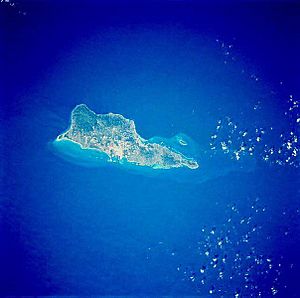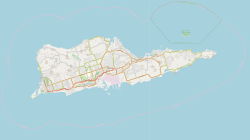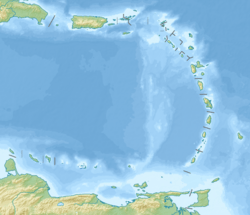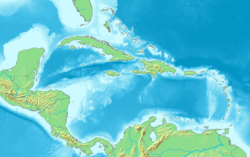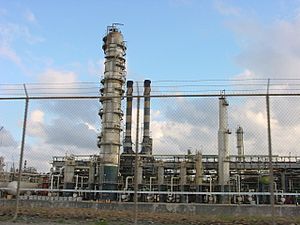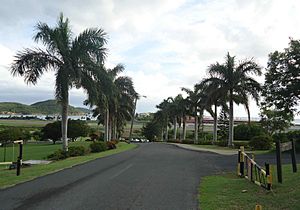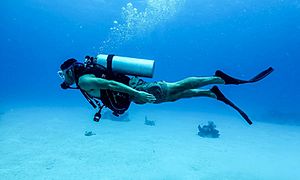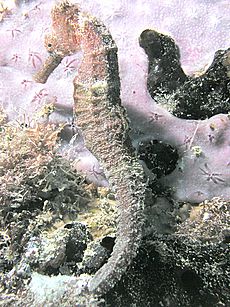Saint Croix facts for kids
|
Nickname: Twin City
|
|
|---|---|
|
Saint Croix from space, January 1992
|
|
| Geography | |
| Location | Caribbean Sea |
| Coordinates | 17°44′23″N 64°44′20″W / 17.73972°N 64.73889°W |
| Archipelago | Virgin Islands, Leeward Islands |
| Area | 82 sq mi (210 km2) |
| Length | 22 mi (35 km) |
| Width | 7 mi (11 km) |
| Highest elevation | 1,165 ft (355.1 m) |
| Highest point | Mount Eagle |
| Administration | |
| Territory | Virgin Islands |
| District | District of Saint Croix |
| Demographics | |
| Demonym | Crucian |
| Population | 50,601 (2010) |
| Pop. density | 610 /sq mi (236 /km2) |
Saint Croix is a beautiful island in the sunny Caribbean Sea. It is also a county and district of the United States Virgin Islands (USVI), which is a territory of the United States.
St. Croix is the biggest island in the USVI. It is about 28 miles (45 km) long and 7 miles (11 km) wide. Even though it's the largest, the capital city, Charlotte Amalie, is on another island called Saint Thomas.
Contents
Island History
The island was first home to different groups of native people long ago. Christopher Columbus arrived here on November 14, 1493. His group was met by the Kalinago people who lived near Salt River.
Over the years, many different countries controlled the island. These included Spain, the Netherlands, the Knights of Malta, and Great Britain. France then owned it from 1650 to 1733. On June 13, 1733, France sold the island to the Danish West India Company. For almost 200 years, St. Croix, St. Thomas, and St. John were known as the Danish West Indies. During this time, many people were brought to the island to work on large farms called plantations.
In 1916, Denmark sold St. Croix, St. Thomas, and St. John to the United States for $25 million in gold. Most people in Denmark and on the islands agreed with the sale. In 1927, the people living on the island became citizens of the United States. In the 1960s, the island started to have more factories and fewer farms. When a large oil refinery closed in 2012, many people lost their jobs.
Island Geography

St. Croix is located at 17°45′N 64°45′W. The easternmost point of the United States is Point Udall on St. Croix. The island covers an area of about 82.88 square miles (214.66 km²).
The land is hilly, but not extremely steep. The highest point is Mount Eagle, which is 1,165 feet (355 meters) tall. The eastern part of the island is very hilly. The northern side, from Christiansted going west, is also steep. From these northern hills, the land gently slopes down to the south coast. This area was once used for growing sugar.
Island Climate
The island has a steady trade wind that blows across it. The western part of the island gets more rain than the eastern end. The amount of rain can change a lot each year, but it averages about 40 inches (1,000 mm).
The east end of the island is dry and desert-like, with many cacti. The west end has lush green plants and palm trees. This means the island has many different types of environments in a small area. Getting enough fresh water has always been a challenge because there are no natural rivers or streams. The island has a plant that turns saltwater into fresh water. Also, most homes and businesses have special tanks called cisterns to collect rainwater.
Island People
People who live on St. Croix are called Crucians (sometimes spelled "Cruzans").
Many people on St. Croix are descendants of enslaved Africans who were brought to the island long ago. Others came from different Caribbean islands. In the 20th century, many people from Puerto Rico moved to St. Croix for work, especially after the sugar industry declined. A local holiday, Puerto Rico/U.S. Virgin Islands Friendship Day, is celebrated every October 10th. Puerto Ricans on St. Croix have kept their culture alive while also becoming part of the Crucian culture. For example, some speak a mix of Puerto Rican Spanish and the local Crucian creole dialect.
Many people also moved to St. Croix from other Caribbean islands, often called "down-island," in the 1960s and 70s. Jobs were plentiful in tourism, aluminum production, and oil refining. These newcomers came from places like St. Kitts & Nevis, Antigua, St. Lucia, and Dominica. People from many other Anglophone Caribbean islands also live on St. Croix.
People from the mainland United States have also moved to St. Croix. Since the 1960s, Arab Palestinians have also played a big role in the local economy, opening shops and gas stations. More recently, people from the Dominican Republic, Haiti, Jamaica, the Philippines, and South American countries have moved to the island.
The total population of St. Croix, according to the 2010 U.S. Census, is 50,601 people.
St. Croix is divided into smaller areas called subdistricts:
- Anna's Hope Village (pop. 4,041)
- Christiansted (pop. 2,626)
- East End (pop. 2,453)
- Frederiksted (pop. 3,091)
- Northcentral (pop. 4,977)
- Northwest (pop. 4,863)
- Sion Farm (pop. 13,003)
- Southcentral (pop. 8,049)
- Southwest (pop. 7,498)
Island Languages
English is the most common language spoken on St. Croix. Danish was once the official language when it was a Danish colony, but it was not widely used.
Spanish is spoken by people from Puerto Rico and the Dominican Republic, and their children born on St. Croix. Different French creoles are spoken by people from St. Lucia, Dominica, and Haiti. A local English-based creole called Crucian is also spoken by most people in casual conversations. Arabic is common among the Palestinian community on St. Croix.
Island Religions
Christianity is the main religion on St. Croix. The island is sometimes called the "Land of Churches" because it has about 150 churches for its 50,000 residents.
Most churches are Protestant, but there are also many Roman Catholic churches. This is due to the large number of Hispanic people and historical Irish influence. Some Protestant groups include Anglican, Methodist, Moravian, Presbyterian, Pentecostal, and Seventh-day Adventists. There are also Jehovah's Witnesses and members of The Church of Jesus Christ of Latter-Day Saints.
Like in many parts of the Caribbean, different forms of Rastafari are practiced on the island. Islam is common among the small local Arab population, and there is also a small Jewish community.
Island Economy
St. Croix used to be a major farming island in the Caribbean. However, this changed in the 1960s when more factories and industries came to the island. Today, like many other Caribbean islands, tourism is one of the main ways St. Croix makes money. Other industries also help the economy.
St. Croix was home to HOVENSA, one of the world's largest oil refineries. This refinery closed down on January 18, 2012. This had a big impact on the economy of St. Croix and the entire U.S. Virgin Islands, as many people lost their jobs.
St. Croix is also home to the Cruzan Rum Distillery, which makes Cruzan Rum. This distillery started in 1760. It used to use sugar cane grown on the island. Now, it brings in molasses from other countries like the Dominican Republic and South America. Cruzan Rum has won many awards for its quality.
Another company, Diageo, has built a new distillery on the island. This distillery produces Captain Morgan Rum.
Getting Around St. Croix
Island roads can be bumpy and have sharp turns because of the hilly land. Cars drive on the left side of the road, but almost all cars on the island have the steering wheel on the left side, like in the United States mainland. This can be tricky for new residents and visitors.
There is a public bus service called Virgin Islands Transit, or VITRAN.
Besides regular taxis and buses, St. Croix also has shared taxis, known as "taxi buses." These are vans that drive a route from Frederiksted to Christiansted. They are privately owned and don't follow a set schedule. People just wave them down from the side of the road. Passengers can get off anywhere along the route. Taxi buses have a flat rate of $2.50. Taxis to specific places are more expensive and are often used by tourists.
The Henry E. Rohlsen International Airport serves St. Croix with flights from the U.S. mainland, Puerto Rico, and the Eastern Caribbean. Seaplanes, operated by Seaborne Airlines, also fly to the island, landing in Christiansted Harbor.
Island Education
The St. Croix School District runs public schools on St. Croix. There are also many private schools, such as St. Croix Montessori and The Good Hope Country Day School.
The island has two colleges: the University of the Virgin Islands (St. Croix campus) and a small campus of Barry University.
Island Culture and Fun
Festivals and Events
St. Croix's biggest festival is the "Crucian Christmas Carnival," celebrated in late December and early January. Another important event is the Agricultural and Food Fair in mid-February.
Several times a year, there's a night festival in Christiansted called "Jump-Up." There's also a monthly event called "Sunset Jazz" in Frederiksted, where local jazz musicians play on Frederiksted Beach. Every year before Mardi Gras, there's a local Mardi Croix parade and a fun dog parade.
The St. Croix Food & Wine Experience happens every April. Famous chefs work with local chefs and students to create amazing dishes. This event celebrates local foods, farms, and drinks like wines and rums.
The St. Croix Half Ironman Triathlon takes place in the first week of May. This race includes a 1.2-mile swim, a 56-mile bike ride, and a 13.1-mile run. The bike route includes a very steep hill called "The Beast," so the triathlon is often nicknamed "Beauty and the Beast."
Places to Visit
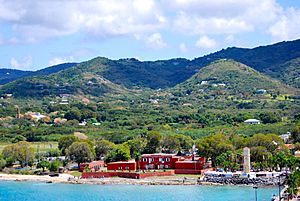
Frederiksted has many old buildings with Victorian era architecture. It was designed with a grid of seven streets by seven streets. Historic places include St. Patrick's Catholic Church (built in the 1840s), the Customs House, and the 19th-century Apothecary. Some old buildings are now beautiful ruins due to past hurricanes. Frederiksted is quieter than other parts of the island, but it gets lively during Carnival in January and when cruise ships visit.
Salt River Bay National Historical Park and Ecological Preserve is a special place. It's the only known spot where Christopher Columbus's expedition landed on what is now U.S. territory. The park also protects important natural areas like mangrove forests and marine environments, which are home to rare animals. You can see Fort Salé here, an old French fort from the 1600s. This park is also one of two places on the island with amazing bioluminescent bays.
Fort Christiansværn, built in 1749, and other buildings are cared for by the National Park Service as the Christiansted National Historic Site.
Buck Island Reef National Monument protects a 176-acre (71 ha) island north of St. Croix and its surrounding coral reefs. It's a popular spot for snorkeling. Buck Island also has a weather station and a place where student scientists study lemon sharks. Green Cay, a small island southwest of Buck Island, also has a popular reef for divers and snorkelers.
Scuba Diving, Snorkeling, and Water Sports
The waters around St. Croix are warm all year (77-86°F), making it a great place for water sports. You can go scuba diving, snorkeling, kayaking, paddleboarding, surfing, kite surfing, parasailing, jet skiing, fishing, and sunset sailing. St. Croix is especially known for its scuba diving, with two famous spots: Frederiksted Pier and the "wall diving" at (Salt River).
Frederiksted is a popular diving spot because of its pier, seahorses, and access to shipwrecks. The waters on this western side of the island are usually very calm, which is perfect for snorkeling right from the beach. Paddleboarding is also popular here. The Frederiksted Pier is a world-class place for scuba diving, snorkeling, and even just jumping into the water. Diving at the Frederiksted Pier is shallow, making it great for beginners or for taking underwater photos.
The north coast of the island (from Salt River to Cane Bay) is known for its "wall diving." Just a short distance from shore, the ocean floor drops suddenly into a deep underwater trench. This area has beautiful coral reefs, many colorful tropical fish, and migrating sea turtles. Kayaking is very popular in the Salt River area.
Christiansted is the largest city. It's located a bit east of the northern drop-off and is protected by a reef. It's also close to Buck Island and Green Cay.
Bioluminescent Bays
St. Croix has two amazing bioluminescent bays, also known as "bio bays." These bays glow at night when the water is disturbed! The most famous one is at Salt River Bay National Historical Park and Ecological Preserve. Another bio bay is found at Altona Lagoon. Bio bays are very rare, with only seven known year-round glowing lagoons in the Caribbean.
A special combination of things makes these bays glow. Red mangrove trees grow around the water. The glow comes from tiny living things called dinoflagellates, which light up when the water moves. Scientists are studying these bays to understand how they work and how to protect them.
The two bio bays on St. Croix are different. The one at Altona Lagoon is large but shallow, so you can see marine life swimming and making the water glow. The bio bay at Salt River is smaller but deeper. Because it's deeper, it's also home to another type of glowing creature called comb-jellies, which are not found at Altona Lagoon.
There's a third glowing creature in Salt River: a type of marine fireworm. These worms perform a brilliant green mating dance about 57 hours after the full moon. The females rise to the surface, leaving a glowing green puddle for the males to swim through.
Protected Areas
St. Croix is home to several national protected areas:
- Buck Island Reef National Monument
- Christiansted National Historic Site
- Green Cay National Wildlife Refuge
- Salt River Bay National Historical Park and Ecological Preserve
- Sandy Point National Wildlife Refuge
- Point Udall
Images for kids
-
Dannebrog being lowered at the Governor's Mansion for the last time (31 March 1917)
-
Saint Croix geologic map, showing different rock types.
See also
 In Spanish: Santa Cruz (Islas Vírgenes) para niños
In Spanish: Santa Cruz (Islas Vírgenes) para niños


